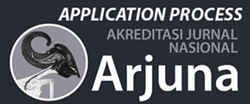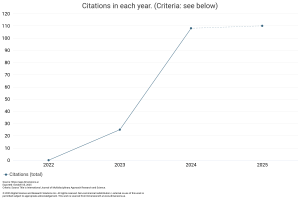Influence of Halal Label, Expiration Date, and Product Composition on Consumer Purchase Decisions Mediated by Purchase Intention at MSME Gallery
DOI:
https://doi.org/10.59653/ijmars.v3i03.1925Keywords:
Halal label, expiration date, product composition, purchase intention, purchase decisionAbstract
This study aims to analyze the influence of halal labels, expiration dates, and product composition on consumer purchase decisions with purchase intention as a mediating variable at the Etham Nusantara MSME Gallery in Samarinda. The research employed a quantitative approach using a survey method with questionnaires, analyzed through Structural Equation Modeling (SEM) with the assistance of SmartPLS. The results indicate that halal labels, expiration dates, and product composition have a positive and significant effect on both purchase intention and purchase decisions, while purchase intention is proven to mediate the influence of these three variables on consumer purchase decisions. These findings highlight the importance of product information transparency in enhancing consumer trust, purchase intention, and purchase decisions, as well as providing strategic implications for MSME actors and gallery managers in strengthening the competitiveness of local products in an increasingly competitive market.
Downloads
References
Adriansyah, A., & Rimadias, S. (2023). Key Factors for University Business Incubator Implementation (UBI): Literature Review. Journal of Business Management and Economic Development, 2(01 SE-Articles), 98–110. https://doi.org/10.59653/jbmed.v2i01.335
Ajzen, I. (1991). The theory of planned behavior. Organizational Behavior and Human Decision Processes, 50(2), 179–211. https://doi.org/10.1016/0749-5978(91)90020-T
Albab Al Umar, M., Salsabila, A., & Wibowo, H. (2021). The effect of halal label and expiration date on consumer purchase decision. Journal of Islamic Marketing, 12(3), 462–475. https://doi.org/10.1108/JIMA-07-2019-0154
Bose, S., Roy, S., & Tiwari, P. (2018). Expiration date and consumer purchase intention: The mediating role of perceived risk. Food Quality and Preference, 68, 86–93. https://doi.org/10.1016/j.foodqual.2018.02.010
Engel, J. F., Blackwell, R. D., & Miniard, P. W. (2012). Consumer behavior (10th ed.). Cengage Learning.
Febrianti, D., Rahmawati, N., & Putra, A. (2022). Product composition transparency and its influence on consumer trust and purchase behavior. International Journal of Business and Society, 23(2), 350–362.
Galib, M., Rahman, A., & Li, J. (2018). Consumer risk perception and expiration date labeling. Journal of Consumer Studies, 45(1), 15–28.
Grunert, K. G. (2023). Food labeling and consumer perception: The role of expiration date. Appetite, 181, 106316. https://doi.org/10.1016/j.appet.2022.106316
Handini, S. (2023). Financial Ratios, Capital Structure, and EVA Impact on IDX Food and Beverage Manufacturers 2019-2021 Performance. Journal of Business Management and Economic Development, 2(01 SE-Articles), 241–257. https://doi.org/10.59653/jbmed.v2i01.400
Hutter, K., Hautz, J., Dennhardt, S., & Füller, J. (2013). The impact of user interactions in social media on brand awareness and purchase intention: The case of MINI on Facebook. Journal of Product & Brand Management, 22(5/6), 342–351. https://doi.org/10.1108/JPBM-05-2013-0299
Jannat, M., & Islam, T. (2019). Halal certification, consumer perception, and purchase decision: Evidence from Muslim consumers. Journal of Islamic Marketing, 10(3), 887–900. https://doi.org/10.1108/JIMA-06-2018-0107
Kotler, P., & Armstrong, G. (2018). Principles of marketing (17th ed.). Pearson Education.
Kotler, P., & Keller, K. L. (2016). Marketing management (15th ed.). Pearson Education.
Li, X., Zhou, Y., & Park, H. (2020). Expiration date and consumer decision-making: Evidence from food consumption. Food Policy, 95, 101935. https://doi.org/10.1016/j.foodpol.2020.101935
Mose, J., & Gachanja, I. (2023). Influence of Performance Appraisal on Employee Performance in the Energy Sector Kenya. Journal of Business Management and Economic Development, 2(01 SE-Articles), 71–87. https://doi.org/10.59653/jbmed.v2i01.329
Njiru, M., & Thoronjo, E. (2023). Analysis of Monitoring and Evaluation Practices on Performance of Non-Governmental Organizations’ Project in Kiambu County, Kenya. Journal of Business Management and Economic Development, 2(01 SE-Articles), 1–12. https://doi.org/10.59653/jbmed.v2i01.308
Park, H., & Lee, J. (2019). The role of expiration date in shaping consumer trust and purchase decision. Journal of Retailing and Consumer Services, 50, 207–214. https://doi.org/10.1016/j.jretconser.2019.05.013
Putri, K. A., & Subawa, I. (2014). The role of expiration date in consumer purchase behavior. International Journal of Marketing Studies, 6(3), 145–152.
Schiffman, L. G., & Wisenblit, J. (2015). Consumer behavior (11th ed.). Pearson.
Silaban, S., Aadilah, H., & Matondang, K. (2023). Influence of Rupiah Exchange Rate on Indonesia’s Economic Growth: Literature Study. Journal of Business Management and Economic Development, 1(02), 123–131. https://doi.org/10.59653/jbmed.v1i02.48
Suwarno, S., Kesuma, I. M., Aprianto, R., Anggraini, S., Nuraini, B., Paleni, H., & Surajiyo, S. (2023). Perceived Organization Support and Work Engagement toward Employee Performance with Motivation as Mediating Variable. Journal of Business Management and Economic Development, 1(02), 230–239. https://doi.org/10.59653/jbmed.v1i02.136
Utami, N. W., Sari, D. A., & Kurniawan, H. (2021). The effect of healthy and organic product composition on consumer purchase intention. Journal of Food Products Marketing, 27(6), 441–456. https://doi.org/10.1080/10454446.2021.1890412
Verbeke, W., Barreiro-Hurlé, J., & Ward, R. W. (2015). Consumer interest in information cues denoting quality, traceability and origin: An application of ordered probit models to beef labels. Food Quality and Preference, 16(6), 463–477. https://doi.org/10.1016/j.foodqual.2004.08.006
Zhao, H., Li, X., & Wang, J. (2021). Price, product information, and consumer purchase decision. Journal of Retailing and Consumer Services, 60, 102456. https://doi.org/10.1016/j.jretconser.2021.102456
Downloads
Published
How to Cite
Issue
Section
Categories
License
Copyright (c) 2025 Rovan Amhar, Gusti Noorlitaria Achmad, Yohanes Kuleh

This work is licensed under a Creative Commons Attribution-ShareAlike 4.0 International License.
Authors who publish with this journal agree to the following terms:
- Authors retain copyright and grant the journal right of first publication with the work simultaneously licensed under a Creative Commons Attribution-ShareAlike that allows others to share the work with an acknowledgement of the work's authorship and initial publication in this journal.
- Authors are able to enter into separate, additional contractual arrangements for the non-exclusive distribution of the journal's published version of the work (e.g., post it to an institutional repository or publish it in a book), with an acknowledgement of its initial publication in this journal.
- Authors are permitted and encouraged to post their work online (e.g., in institutional repositories or on their website) prior to and during the submission process, as it can lead to productive exchanges, as well as earlier and greater citation of published work (See The Effect of Open Access).
























